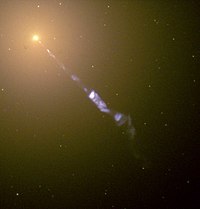
Photo from wikipedia
Relativistic magnetized jets from active galaxies are among the most powerful cosmic accelerators, but their particle acceleration mechanisms remain a mystery. We present a new acceleration mechanism associated with the… Click to show full abstract
Relativistic magnetized jets from active galaxies are among the most powerful cosmic accelerators, but their particle acceleration mechanisms remain a mystery. We present a new acceleration mechanism associated with the development of the helical kink instability in relativistic jets, which leads to the efficient conversion of the jet's magnetic energy into nonthermal particles. Large-scale three-dimensional ab initio simulations reveal that the formation of highly tangled magnetic fields and a large-scale inductive electric field throughout the kink-unstable region promotes rapid energization of the particles. The energy distribution of the accelerated particles develops a well-defined power-law tail extending to the radiation-reaction limited energy in the case of leptons, and to the confinement energy of the jet in the case of ions. When applied to the conditions of well-studied bright knots in jets from active galaxies, this mechanism can account for the spectrum of synchrotron and inverse Compton radiating particles, and offers a viable means of accelerating ultrahigh-energy cosmic rays to 10^{20} eV.
Journal Title: Physical review letters
Year Published: 2018
Link to full text (if available)
Share on Social Media: Sign Up to like & get
recommendations!